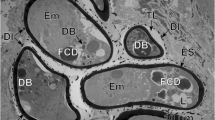Summary
The embryophore (inner capsule) of the tapeworm Shipleya inermis was studied with histochemistry and electron microscopy. It was found to be unique for the cestodes in that it has a laminated construction. During development lamina are added until there are 10 which are arranged in an irregular zig-zag pattern. The embryophore is positive to tests for acid and alkaline phosphatase, and the Hales test for acid mucopolysaccharides. Permeability of tapeworm egg coverings is discussed.
Similar content being viewed by others
References
Caley, J.: In vitro hatching of the tapeworm Moniezia expansa (Cestoda: Anoplocephalidae) and some properties of the egg membranes. Z. Parasitenk. 45, 335–346 (1975)
Coil, W. H.: Observations on the embryonic development of the cyclophyllidean cestode Diplophallus polymorphus with emphasis on the histochemistry of the egg membranes. Z. Parasitenk. 29, 356–373 (1967)
Coil, W. H.: Observations on the embryonic development of the dioecious tapeworm Infula macrophallus with emphasis on the histochemistry of the egg membranes. Z. Parasitenk. 30, 301–317 (1968)
Coil, W. H.: Studies on the biology of the tapeworm Shipleya inermis Fuhrmann, 1908. Z. Parasitenk. 35, 40–54 (1970)
Gönnert, R., Thomas, H.: Einfluß von Verdauungssäften auf die Eihüllen von Taenia-Eiern. Z. Parasitenk. 32, 237–253 (1969)
Johri, L. N.: A morphological and histochemical study of egg formation in a cyclophyllidean cestode. Parasitology 47, 21–29 (1957)
Lethridge, R. C.: The chemical composition and some properties of the egg layers in Hymenolepis diminuta eggs. Parasitology 63, 275–288 (1971)
Lumdsen, R. D.: Preparatory technique for electron microscopy. In: MacInnis & Voge, eds. Experiments on techniques in parasitology. San Francisco: W. H. Freeman and Co. 1970
Moczoń, T.: Histochemistry of oncospheral envelopes of Hymenolepis diminuta (Rudolphi, 1819) (Cestoda, Hymenolepidae). Acta parasit. pol. 20, 517–531 (1972)
Pence, D. B.: The fine structure and histochemistry of infective eggs of Dipylidium caninum. J. Parasit. 53, 1041–1054 (1967)
Rybicka, K.: Ultrastructure of embryonic envelopes and their differentiation in Hymenolepis diminuta (Cestoda). J. Parasit. 58, 849–863 (1972)
Swiderski, Z.: Electron microscopy and histochemistry of oncospheral hook formation by the cestode Catenotaenia pusilla. Int. J. Parasit. 3, 27–33 (1973)
Author information
Authors and Affiliations
Additional information
This study was supported by grants: AI 05145 from the National Institute of Allergy and Infections Diseases, FR-07037 from the Biomedical Science Support Grant and GB 2353 from the National Science Foundation.
Rights and permissions
About this article
Cite this article
Coil, W.H. The histochemistry and fine structure of the embryophore of Shipleya inermis (Cestoda). Z. F. Parasitenkunde 48, 9–14 (1975). https://doi.org/10.1007/BF00389824
Received:
Issue Date:
DOI: https://doi.org/10.1007/BF00389824




